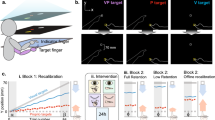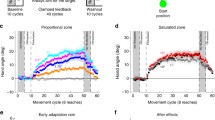Abstract
Previous studies have found that sensorimotor adaptation to visual distortions is degraded in seniors compared with younger subjects, whereas after-effects on removal of the distortion are age-independent. The latter finding was interpreted as evidence that adaptive recalibration is not affected by old age, and that the observed degradation is therefore due to impairment of strategic control. However, after-effects are not a reliable measure of recalibration, because they can be artificially inflated by perseveration, a characteristic symptom in old age. The present work therefore introduces a test of recalibration which is insensitive to perseveration. Twelve young and twelve old subjects executed center-out pointing movements while visual feedback about their fingertip was either veridical (baseline), 60-deg rotated (adaptation), or absent (after-effect).They also executed tracking movements toward an unpredictably moving object before and after the pointing task. Seniors adapted less than younger subjects but their after-effects were not degraded. More importantly, transfer of adaptation from a pointing to a tracking task was not degraded in seniors. The latter outcome documents, in a more compelling fashion than previous work, that recalibration in the elderly is not impaired, and that the observed deficit of adaptation is therefore most probably because of impaired strategic control. This conclusion is supported by two additional findings: compared with young subjects our seniors performed less well on a cognitive screening test and acquired no explicit knowledge about the nature of the imposed visual distortion.


Similar content being viewed by others
Notes
Subjects scored their participation in twelve common physical activities such as “stair climbing” and “handcrafting” on a five-point scale from “never” to “daily”. Mann–Whitney tests yielded no significant differences between age groups for any activity except “leisurely walks” (U=27.5; P<0.05), where seniors reported more frequent activity than the younger participants.
References
Abeele S, Bock O (2003) Transfer of sensorimotor adaptation between different movement categories. Exp Brain Res 148:128–132
Bock O (1992) Adaptation of aimed arm movements to sensorimotor discordance: evidence for direction-independent gain control. Behav Brain Res 51:41–50
Bock O, Burghoff M (1997) Visuo-motor adaptation: evidence for a distributed amplitude control system. Behav Brain Res 89:267–273
Bock O, Schneider S (2002) Sensorimotor adaptation in young and elderly humans. Neurosci Biobehav Rev 26:761–767
Buch E, Young S, Contreras-Vidal J (2003) Visuomotor adaptation in normal aging. Learn Mem 10:55–63
Canavan AGM, Passingham RE, Marsden CD, Quinn N, Wyke M, Polkey CE (1990) Prism adaption and other tasks involving spatial abilities in patients with Parkinson’s disease, patients with frontal lobe lesions and patients with unilateral temporal lobectomies. Neuropsychologia 28:969–984
Cerella J (1990) Aging and information-processing rate. In: Birren JE, Schaie KW (eds) Handbook of the psychology of aging. Hartcourt, San Diego, pp 210–221
Cunningham H, Welch R (1994) Multiple concurrent visual- motor mappings: Implication for models of adaptation. J Exp Psychol 20:987–999
Etnier JL, Landers DM (1998) Motor performance and motor learning as a function of age and fitness. R Q Exercise Sports 69:136–146
Fernández-Ruiz J, Hall C, Vergara P, Díaz R (2000) Prism adaptation in normal aging: slower adaptation rate and larger after effect. Cognit Brain Res 9:223–226
Jakobson L, Goodale M (1989) Trajectories of reaches to prismatically-displaced targets: evidence for “automatic” visuomotor recalibration. Exp Brain Res 78:575–587
Kohler I (1955) Experiments with prolonged optical distortions. Acta Psychol 11:176–178
McNay EC, Willingham DB (1998) Deficit in learning of a motor skill requiring strategy, but not of perceptualmotor recalibration, with aging. Learn Mem 4:411–420
Nagahama Y, Fukuyama H, Yamauchi H, Katsumi Y, Magata Y, Shibasaki H, Kimura J (1997) Age-related changes in cerebral blood flow activation during a card sorting test. Exp Brain Res 114:571–577
Raz N (ed) (2000) Aging of the brain and its impact on cognitive performance: integration of structural and functional findings. Erlbaum, Hillsdale, NJ
Raz N, Gunning-Dixon F, Head D, Dupuis J, McQuain J, Briggs S, Loken W, Thornton A, Acker J (1997) Selective aging of the human cerebral cortex observed in vivo: differential vulnerability of the prefrontal gray matter. Cereb Cortex 7:268–282
Raz N, Williamson A, Gunning-Dixon F, Head D, Acker J (2000) Neuroanatomical and cognitive correlates of adult age differences in acquisition of a perceptual-motor skill. Microsc Res Tech 51:85–93
Redding G (1996) Adaptive spatial alignment and strategic perceptual-motor control. J Exp Psychol: Hum Percept Perform 22:379–394
Ridderinkhof K, Span M, van der Molen M (2002) Perseverative behavior and adaptive control in older adults: performance monitoring, rule induction, and set shifting. Brain Cognit 49:382–401
Roller C, Cohen H, Kimball K, Bloomberg J (2002) Effects of normal aging on visuo-motor plasticity. Neurobiol Aging 23:117–123
Shadmehr R, Moussavi ZMK (2000) Spatial generalization from learning dynamics of reaching movements. J Neurosci 15:7807–7815
Shadmehr R, Mussa-Ivaldi F (1994) Adaptive representation of dynamics during learning of a motor task. J Neurosci 14:3208–3224
Stratton GM (1897) Vision without inversion of the retinal image. Psychol Rev 4:341–481
Volkow N, Gur R, Gwang G-J, Fowler J, Moberg P, Ding Y-S, Hitzemann R, Smith G, Logan J (1998) Association between decline in brain dopamine activity with age and cognitive and motor impairment in healthy individuals. Am J Psychiatr 155:344–349
Wolpert DM, Ghahramani Z, Jordan MI (1995) An internal model for sensorimotor integration. Science 269:1880–1882
Wright B, Payne R (1985) Effects of aging on sex differences in psychomotor reminiscence and tracking proficiency. J Gerontol 40:179–184
Acknowledgements
Thanks are due to Dr U. Eversheim, L. Frentjen, S. Halbe, and K. Steinbrink for their help with data collection and analysis, and to Dipl-Ing.(FH) L. Geisen who developed the software for data acquisition and screening. This work was funded by DFG-Grant 649/8.
Author information
Authors and Affiliations
Corresponding author
Rights and permissions
About this article
Cite this article
Bock, O. Components of sensorimotor adaptation in young and elderly subjects. Exp Brain Res 160, 259–263 (2005). https://doi.org/10.1007/s00221-004-2133-5
Received:
Accepted:
Published:
Issue Date:
DOI: https://doi.org/10.1007/s00221-004-2133-5




